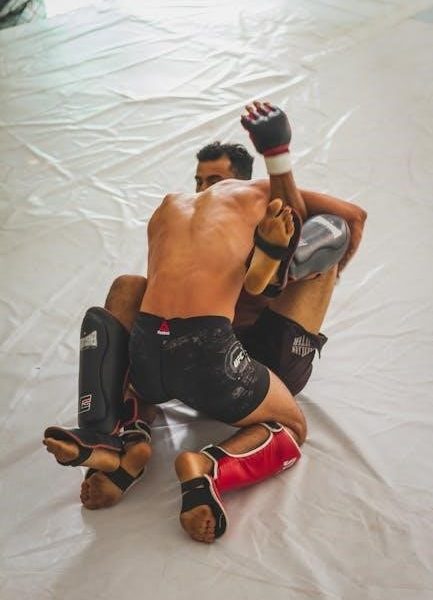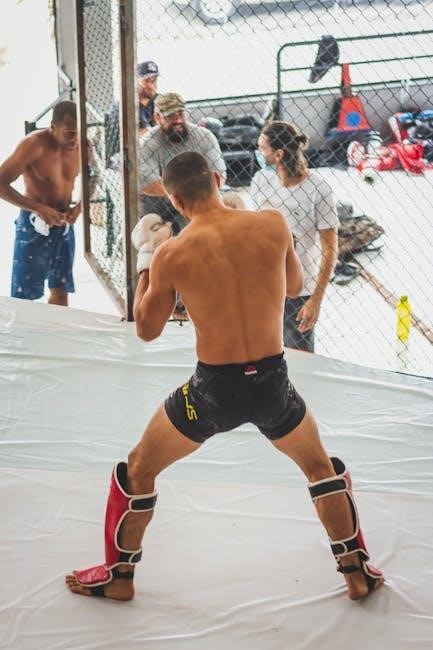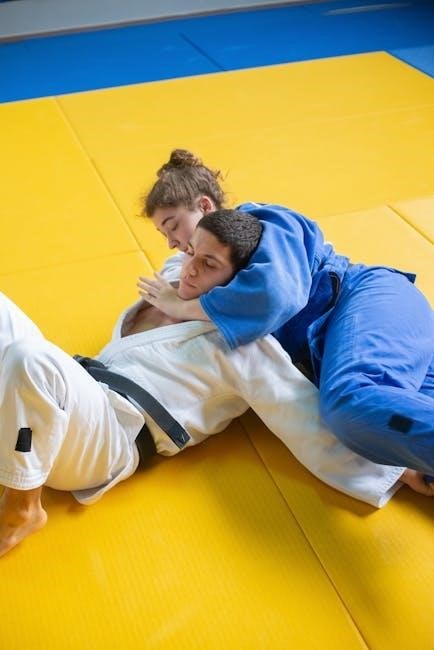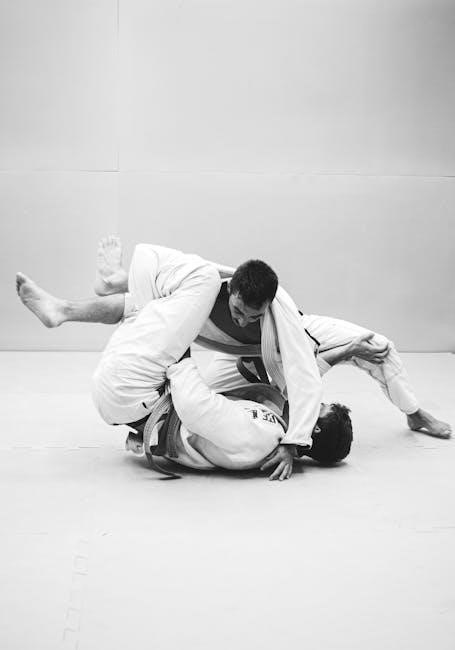
bjj fundamentals pdf
Brazilian Jiu-Jitsu fundamentals form the cornerstone of this martial art, emphasizing core techniques and positions. PDF guides and e-books provide detailed insights into essential moves, enabling practitioners to master the basics effectively and build a strong foundation for advanced training.
1.1 Importance of Mastering the Basics
Mastering the fundamentals of Brazilian Jiu-Jitsu is crucial for building a strong foundation. Without a solid understanding of basic principles, techniques, and positions, progress becomes challenging. The Guard position, for instance, is central to BJJ and is often considered the most complex to master. By focusing on fundamental movements and techniques, practitioners can develop instinctive reflexes and improve their performance in real-world situations. PDF guides and instructional materials emphasize the necessity of dedicating time to these basics, as they serve as the building blocks for more advanced strategies. Neglecting the fundamentals can lead to poor technique execution and increased vulnerability during training or competition.
1.2 Overview of Key Positions and Techniques
Key positions in Brazilian Jiu-Jitsu include the Mount, Side Control, Guard, and Back positions, each offering unique control and submission opportunities. The Guard, considered the most complex, allows for offensive and defensive strategies. Essential techniques encompass escapes, submissions, and transitions. Escapes enable practitioners to regain advantageous positions, while submissions like armbars and chokes finish matches. Transitions involve fluid movement between positions to maintain control. These elements form the backbone of BJJ, providing a structured approach to ground fighting. Mastery of these basics ensures a strong foundation, allowing practitioners to adapt to various scenarios effectively. PDF guides often detail these positions and techniques, offering visual and step-by-step instructions for better understanding and execution.
Core BJJ Positions
Core BJJ positions include Mount, Side Control, Guard, and Back. Each offers unique control and submission opportunities, forming the foundation of ground fighting mastery in BJJ.
2.1 The Mount Position
The Mount is a dominant position in BJJ, where the practitioner sits on the opponent’s torso. It allows for effective strikes and submission holds like armbars and chokes. Proper alignment and balance are crucial to maintain control. In various resources, the Mount is highlighted as a fundamental position for beginners to master, as it emphasizes body positioning and weight distribution. PDF guides often include detailed diagrams and step-by-step instructions to help learners achieve and maintain this position effectively. Mastery of the Mount is essential for advancing in BJJ, as it serves as a foundation for more complex techniques and strategies.
2.2 Side Control
Side Control is a fundamental position in BJJ where the practitioner controls the opponent from the side. It emphasizes balance, pressure, and body positioning to prevent escapes. Proper alignment of the hips and shoulders is vital to maintain dominance. Transitioning to Side Control often follows escapes or sweeps, making it a versatile position in both offensive and defensive scenarios. PDF guides and instructional materials frequently highlight Side Control as a key position for developing control and transitions. Mastery of Side Control enhances a practitioner’s ability to move seamlessly to other dominant positions, such as the Mount or North-South, while setting up submissions like kimuras or Americana. Effective Side Control is a cornerstone of BJJ strategy at all skill levels.
2.3 Guard Position
The Guard is a central and complex position in BJJ, often considered the most challenging to master. It involves using the legs to control the opponent while on one’s back, allowing for both defensive and offensive strategies. The Guard can be subdivided into variations like the Closed Guard, Open Guard, and Half Guard, each with unique applications. Proper alignment, balance, and timing are crucial to effectively execute sweeps, submissions, or transitions from the Guard. PDF guides and instructional materials frequently emphasize the importance of mastering the Guard, as it is a cornerstone of BJJ fundamentals. Proficiency in the Guard enables practitioners to neutralize larger and stronger opponents, making it an indispensable skill for all levels of training.
2.4 Back Position
The Back Position is one of the most dominant positions in BJJ, offering a high level of control over the opponent. It involves securing a seatbelt grip around the opponent’s torso while maintaining hooks with the legs. This position is highly advantageous for executing submissions, such as rear-naked chokes or joint locks, and is commonly utilized in both sport BJJ and MMA. Proper body alignment, balance, and pressure are essential to maintain control and prevent the opponent from escaping. The Back Position is a fundamental aspect of BJJ training, as it teaches practitioners how to transition from other positions and finish fights effectively. Mastering this position requires consistent drilling and live application during sparring sessions.

Essential Techniques
Essential Techniques in BJJ are categorized into escapes, submissions, and transitions. These form the foundation for effective combat, enabling control, finishing, and fluid movement between positions.
3.1 Escapes: Fundamental Movements
Escapes are vital in BJJ, allowing practitioners to regain control from unfavorable positions. Techniques like shrimping, bridging, and hip heists are essential for mounting effective escapes. These movements require precise timing and body positioning to execute successfully. PDF guides often detail step-by-step methods for mastering escapes, emphasizing the importance of drilling to build muscle memory. Proper escape techniques not only enhance survival in live situations but also create opportunities for counterattacks. By understanding the mechanics behind each escape, students can improve their overall game and develop a more well-rounded skill set.
3.2 Submissions: Key Techniques
Submissions are the cornerstone of BJJ, designed to force opponents into tapping via joint locks or chokes. Techniques like armbars, triangle chokes, and Americana shoulder locks are fundamental. PDF guides detail these methods, emphasizing proper leverage and timing. Mastering submissions requires precision and control, ensuring safety while applying pressure. They are integral to both sport BJJ and self-defense, allowing practitioners to end conflicts decisively. Regular drilling and sparring help refine these techniques, making them instinctive during live situations. Understanding submissions is crucial for advancing in BJJ, as they represent the art’s core philosophy of defeating larger opponents with technique over strength.
3.3 Transitions: Moving Between Positions
Transitions in BJJ involve seamlessly moving between positions to maintain control or escape unfavorable situations. They are critical for fluid gameplay, allowing practitioners to adapt quickly. Key techniques include shifting from Guard to Mount, escaping Side Control, or transitioning to the Back position. PDF guides often highlight drills to master these movements, emphasizing timing and body positioning. Smooth transitions prevent opponents from stabilizing and create opportunities for submissions or improved positioning. Practicing these movements enhances overall fluidity and competitive effectiveness, making them a vital part of fundamental training. Regular drilling and live sparring help develop muscle memory for these transitions, ensuring they become second nature during rolls.

Training Methodologies
Effective BJJ training methodologies include drills, sparring, and conditioning to build skill and endurance. Drills enhance technique precision, while live sparring applies them in real scenarios for continuous improvement.
4.1 Drills for Skill Development
Drills are a cornerstone of BJJ training, designed to reinforce fundamental techniques and build muscle memory. They involve repetitive practice of specific movements, such as escapes, transitions, and submissions, allowing practitioners to master the intricacies of each technique. Common drills include positional drills, which focus on maintaining and transitioning between core positions like guard, mount, and side control. Transition drills emphasize smooth movements between these positions, while isolation drills break down complex techniques into manageable parts for focused practice. By repeating these exercises, students develop precision, speed, and reflexes, laying a solid foundation for advanced training. Regular drilling accelerates skill development and enhances overall performance on the mat.

4.2 Sparring: Applying Techniques in Live Situations
Sparring, often referred to as “rolling” in BJJ, is a dynamic way to apply techniques in real-time situations. It bridges the gap between drills and actual combat, allowing practitioners to test their skills under varying levels of resistance. Live sparring helps develop problem-solving abilities, adaptability, and composure under pressure. By engaging in controlled matches, students learn to fluidly transition between positions, execute submissions, and defend against opponents’ moves. This practice is essential for refining timing, balance, and coordination. Sparring also fosters a competitive mindset and builds endurance, preparing practitioners for the intensity of real-world applications. Regular sparring sessions are a key component of BJJ training, enabling students to transform theoretical knowledge into practical proficiency.

4.3 Conditioning for BJJ
Conditioning is a critical aspect of Brazilian Jiu-Jitsu, ensuring practitioners can endure the physical demands of training and competition. A well-structured conditioning program focuses on building cardiovascular endurance, muscular strength, and flexibility. BJJ-specific exercises such as interval drills, plyometrics, and core workouts simulate the intensity of live situations. Proper conditioning enhances stamina, allowing for prolonged rolling sessions and improved performance over time. It also reduces the risk of injuries by strengthening key muscle groups used in BJJ movements. Many PDF guides and resources outline effective conditioning routines tailored for different skill levels, helping practitioners optimize their physical preparation and achieve peak performance on the mat.
Resources and Materials
Explore comprehensive BJJ fundamentals PDF guides and online resources, offering detailed techniques, diagrams, and training tips. These materials are essential for both beginners and advanced practitioners, providing structured learning pathways to master the art of Brazilian Jiu-Jitsu effectively.
5.1 Recommended PDF Guides
Recommended BJJ fundamentals PDF guides offer in-depth instruction on essential techniques, positions, and strategies. These resources are ideal for both beginners and advanced practitioners, providing clear diagrams and step-by-step instructions. Titles like “The Beginners Guide to BJJ” and “Fundamentals of Jiujitsu” are highly regarded for their comprehensive coverage of core concepts. Many guides include drills, training tips, and real-world applications, ensuring a well-rounded understanding of the art. They also often cover the history and philosophy of BJJ, adding context to the technical aspects. These PDFs are accessible and convenient, allowing learners to study and practice at their own pace. They serve as invaluable tools for mastering the foundation of Brazilian Jiu-Jitsu and improving overall skill levels.
5.2 Online Resources for Further Learning
Various online platforms offer extensive resources to deepen your understanding of BJJ fundamentals. Websites provide instructional videos, tutorials, and forums where practitioners share techniques and experiences. Many sites host PDF guides and e-books, such as “The Crucial Importance of Fundamentals” and “Brazilian Jiu-Jitsu Basics”, which cover essential positions and techniques. Additionally, online communities and forums discuss topics like escapes, submissions, and transitions, offering insights from experienced instructors. These resources are invaluable for continuous learning, allowing you to explore advanced concepts and refine your skills. They also provide opportunities to connect with other practitioners, fostering a supportive and knowledge-rich environment for growth in Brazilian Jiu-Jitsu.
Leave a Reply
You must be logged in to post a comment.